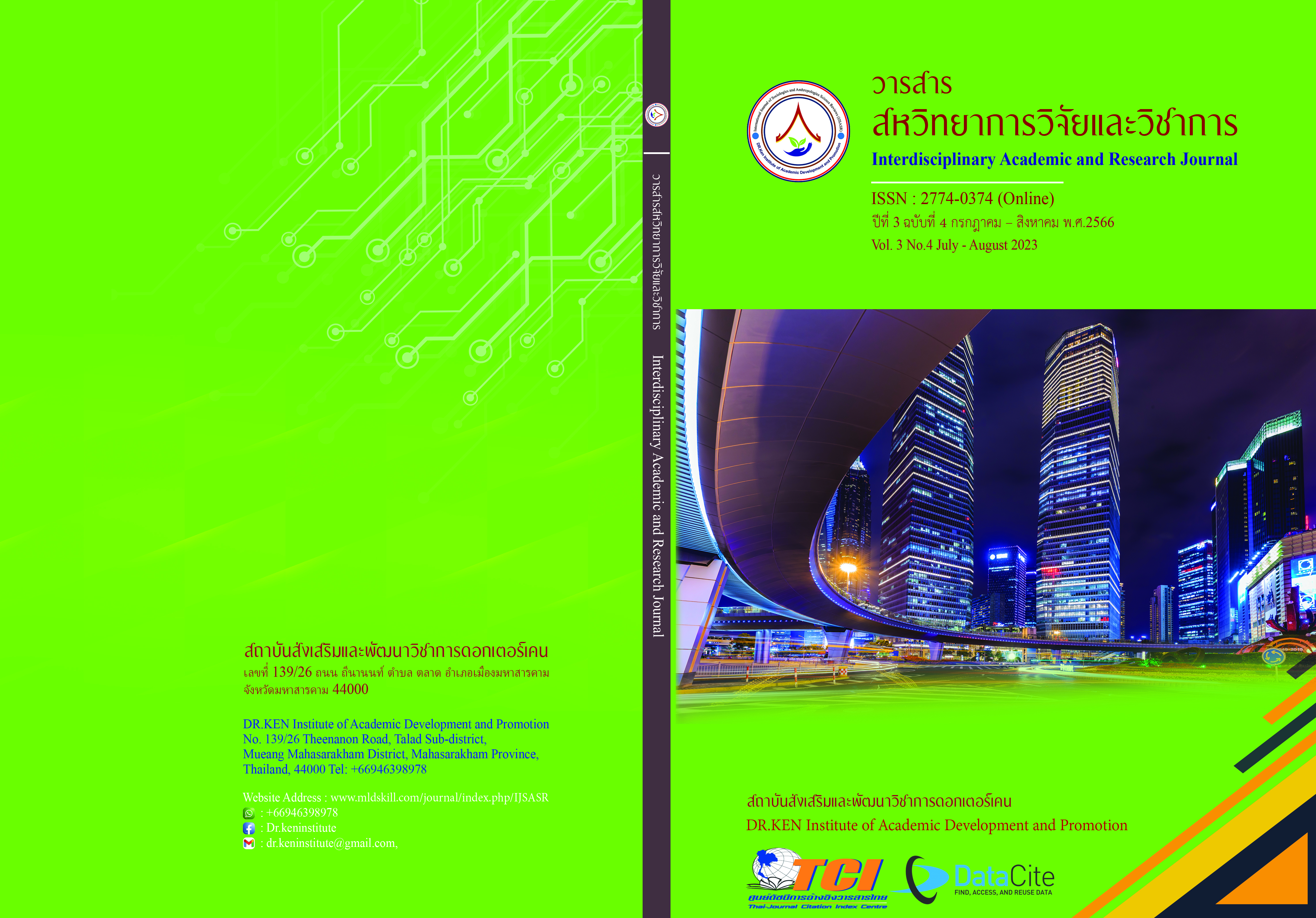The Enhancement of Learning Motivation by Using Blended Learning with Think-pair-share Technique for Prathomsueksa 4 Students of Dondoo School
DOI:
https://doi.org/10.14456/iarj.2023.218Keywords:
Blended learning; , Think-pair-share Technique;, Learning MotivationAbstract
Enhancing achievement motivation is an important element that helps learners to persevere and determines their goals and academic outcomes. Motivation is the process by which a person is motivated by an intentional stimulus to act to achieve an objective, the learner becomes motivated, and teachers should motivate and build academic skills through teaching strategies that guide learners' learning methods. This research aims to 1) Study the promotion of motivation for academic achievement by managing blended learning with the think-pair-share technique. 2) to study the relationship between learning achievement and learning Achievement Motivation. 3) Study the student's satisfaction with learning. by managing blended learning with the Think-pair-share technique Procedure based (PAOR) The target group used in the research were 8 students in Prathom Suksa 4, Ban Don Du School. Under the Office of Maha Sarakham Primary Education Service Area 1 The research tool was a blended learning management plan using peer-to-peer technique. Motivation form for learning achievement Achievement test, annotated form, a behavioral observation form, and a satisfaction questionnaire. The statistics used in the research were mean, standard deviation, and correlation coefficient. The results of the research revealed that 1) promoting motivation for learning achievement. by managing blended learning with the think-pair-share technique. There are 5 steps, including the introduction to the lesson. teaching and problem-solving buddy step Group Work and Presentation and Summary and Assessment by providing a learning environment both in the classroom and online. 2) The motivation for learning achievement and learning achievement were positively correlated, and 3) Students are satisfied with the blended learning activities. with the technique of a partner who thinks at the highest level.
References
กระทรวงศึกษาธิการ. (2551). หลักสูตรแกนกลางการศึกษาขั้นพื้นฐาน พุทธศักราช 2551. กรุงเทพฯ: โรงพิมพ์ชุมนุมสหกรณ์การเกษตรแห่งประเทศไทย จำกัด.
ดลฤดี ไชยศิริ. (2562). การส่งเสริมแรงจูงใจใฝ่สัมฤทธิ์ทางการเรียน โดยใช้การเรียนรู้แบบผสมผสานร่วมกับแนวคิดเกมิฟิเคชัน สำหรับนักเรียนชั้นมัธยมศึกษาปีที่ 4 โรงเรียนผดุงวิทยา. วิทยานิพนธ์มหาบัณฑิต มหาวิทยาลัยราชภัฎมหาสารคาม, มหาสารคาม.
ประหยัด จิระวรพงศ์. (2553). Accelerated learning: กลยุทธ์ทางการเรียนรู้ที่น่าศึกษา. วารสารศึกษาศาสตร์ มหาวิทยาลัยบูรพา. 21 (2), 1-8.
ผกาวัลย์ นามนัย. (2562). การพัฒนาผลสัมฤทธิ์ทางการเรียน เรื่อง กฎหมายและการดำเนินชีวิตและพัฒนาความสามารถในการแก้ปัญหาอย่างมีวิจารณญาณชั้นมัธยมศึกษาปีที่ 3 โดยใช้กิจกรรมการเรียนรู้เชิงรุก. วิทยานิพนธ์ปริญญาการศึกษามหาบัณฑิต สาขาวิชาหลักสูตร และการสอน คณะศึกษาศาสตร์ มหาวิทยาลัยมหาสารคาม.
มนต์ชัย เทียนทอง. (2551).เทคนิคการเรียนรู้แบบร่วมมือแบบ Mentor Coached Think-Pair-Share เพื่อเพิ่มผลสัมฤทธิ์ทางการเรียนในการเรียนรู้ออนไลน์. วารสารวิชาการพระจอมเกล้าพระนครเหนือ, 18 (1), 99-105.
เมธี ธรรมวัฒนา. (2555). กลยุทธ์การสร้างแรงจูงใจที่มีประสิทธิภาพในชั้นเรียน. วารสารศึกษาศาสตร์ มหาวิทยาลัยบูรพา. 23 (3), 17-26.
โมลี สุทฺธิโมลิโพธ. (2563). ลักษณะของบุคคลที่มีแรงจูงใจใฝ่สัมฤทธิ์. วารสารพุทธจิตวิทยา, 5 (2), 12-17.
วัฒนาพร ระงับทุกข์. (2542). แผนการสอนที่เน้นผู้เรียนเป็นศูนย์กลาง. กรุงเทพฯ: สุวีริยาสาส์น.
สังคมไชยสงเมือง. (2560). การพัฒนาระบบการเรียนการสอนแบบผสมผสานโดยใช้โครงงานเป็นฐานเพื่อส่งเสริมทักษะการแก้ปัญหาและทักษะการใช้เทคโนโลยีสำหรับนักเรียนชั้นมัธยมศึกษาปีที่ 3 สังกัดองค์การบริหารส่วนจังหวัดมหาสารคาม. วิทยานิพนธ์ปรัชญาดุษฎีบันฑิต: มหาวิทยาลัยมหาสารคาม
สุวิธิดา จรุงเกียรติกุล. (2561). ทักษะการเรียนรู้ในศตวรรษที่ 21. Retrieved on 25 September 2021. Form https://www.trueplookpanya.com/education/content/66054/
อาทิตย์ สุริฝ้าย. (2557). การปฏิบัติการส่งเสริมแรงจูงใจใฝ่สัมฤทธิ์ทางการเรียน โดยใช้รูปแบบห้องเรียนกลับด้านร่วมกับเทคนิคการเรียนการสอนแบบผสมผสานผ่านเครือข่ายสังคมออนไลน์ กรณีเฟสบุ๊ก. วิทยานิพนธ์ปริญญามหาบัณฑิต: มหาวิทยาลัยราชภัฏมหาสารคาม.
Allen, E, & Seaman, J. (2010). Learning on demand: Online education in the United States. USA: Sloan Consortium.
Best, J. W. (1977). Research in Education. New Jersey: Prentice Hall Inc.
Kemmis, S., & McTaggart, R. (1992). The Action Research Planner. 3rd edition. Geelong: Deakin University Press.
Lyman, F. (1987). Think-Pair-Share: An Ending Teaching Technique. MAA-CIE Cooperative News, 1, 1-2.
Downloads
Published
How to Cite
Issue
Section
License
Copyright (c) 2023 Apichart Wichaiyo, Sanit Teemueangsai, Ubonwan Juntarasena

This work is licensed under a Creative Commons Attribution-NonCommercial-NoDerivatives 4.0 International License.
Copyright on any article in the Interdisciplinary Academic and Research Journal is retained by the author(s) under the under the Creative Commons Attribution-NonCommercial-NoDerivatives 4.0 International License. Permission to use text, content, images, etc. of publication. Any user to read, download, copy, distribute, print, search, or link to the full texts of articles, crawl them for indexing, pass them as data to software, or use them for any other lawful purpose. But do not use it for commercial use or with the intent to benefit any business.
















.png)


